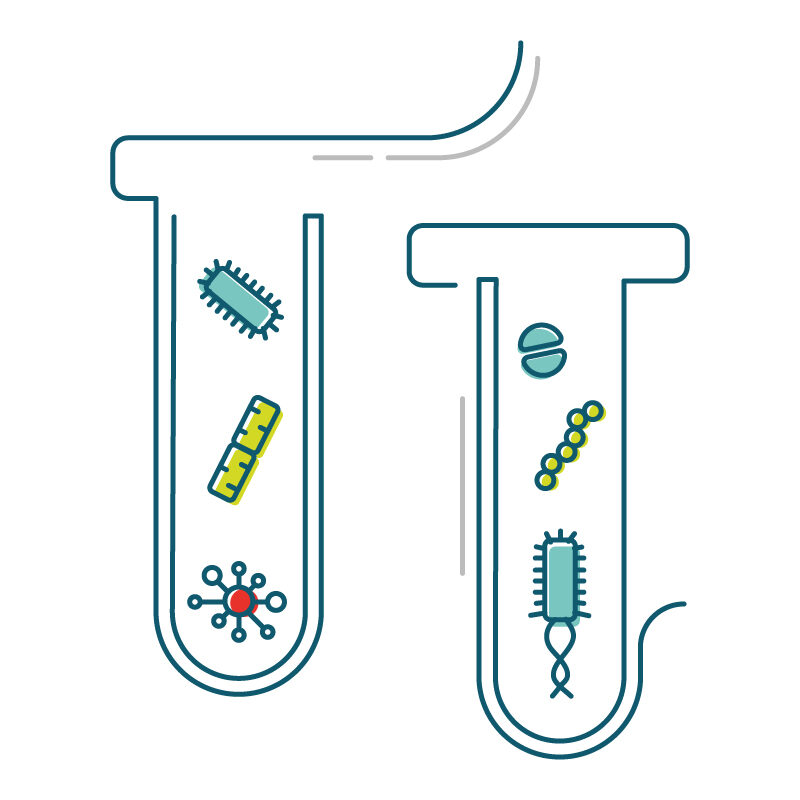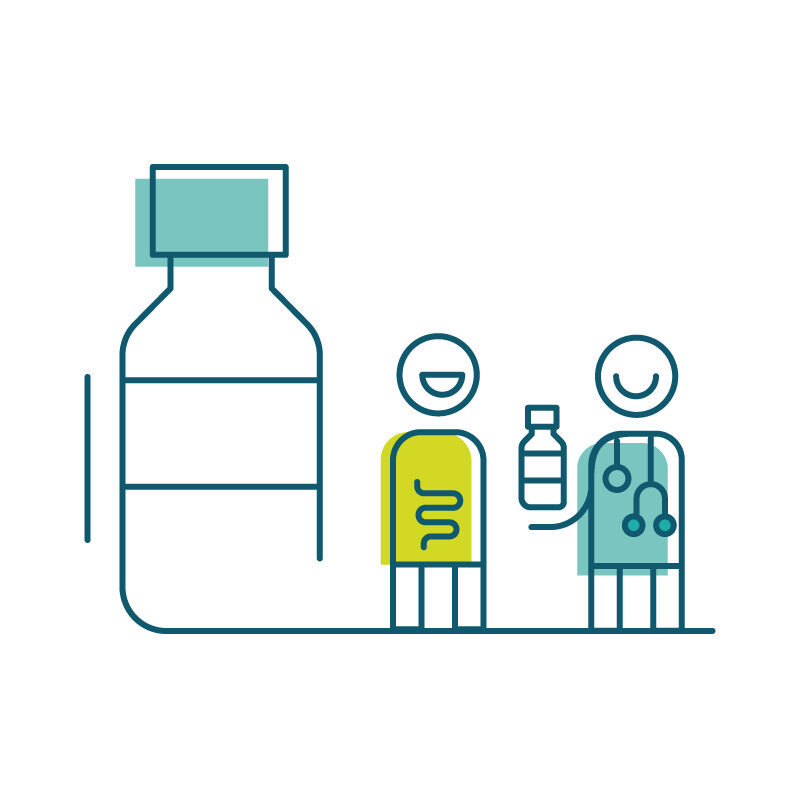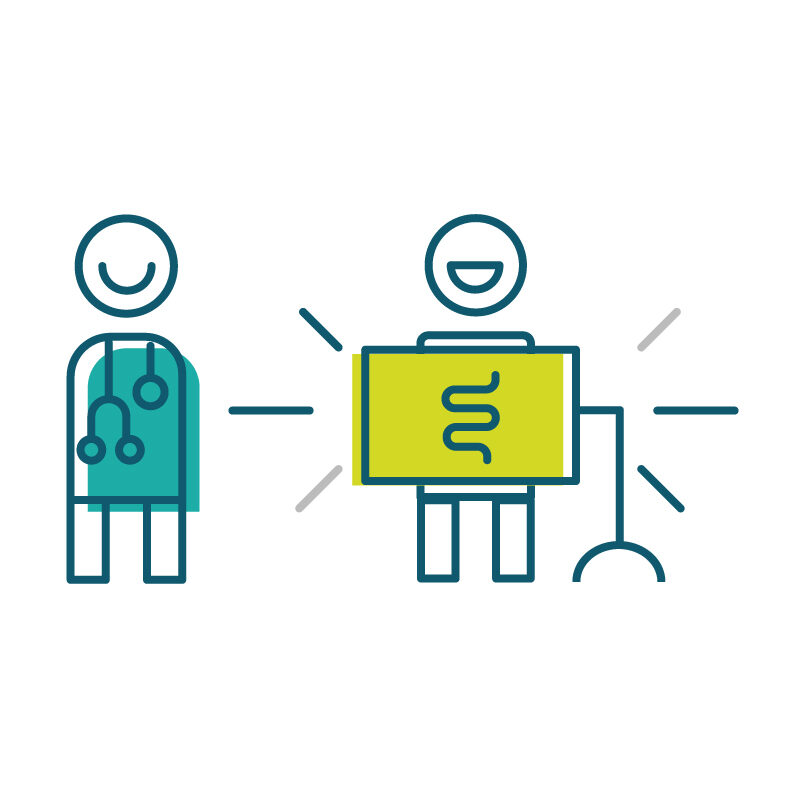
Patient FAQ
This FAQ serves as a general guide for patients looking to learn more about C. difficile and investigational FMT. Please reach out with more questions by emailing info@openbiome.org or calling (617) 575-2201.
About C. difficile

Clostridioides difficile is a rod shaped bacteria that infects about 500,000 people in the United States each year, leading to 30,000 deaths. C. difficile is the most common hospital-acquired infection in the United States and is classified as an urgent antibiotic-resistant threat by the Centers for Disease and Health Control and Prevention.
C. difficile typically infects the large intestine where it produces toxins that kill cells and cause inflammation. Patients experience nausea, diarrhea, and chronic diarrhea. In severe cases, patients may experience watery diarrhea as often as 15 times a day and life-threatening weight loss.
C. difficile is shed through feces and may be spread when people do not practice proper hygiene. For example, when people who carry C. difficile do not wash their hands after going to the bathroom, they can contaminate food and leave the bacteria on surfaces, exposing others who come into contact with them. Not everyone with C. difficile experiences symptoms. Up to 10% of the U.S. population may be carriers of C. difficile who do not show signs of illness but are still able to infect others.
Most healthy people will resist C. difficile infections thanks to the diversity of microorganisms in their gut. These microbes repel C. difficile by competing for nutrients and occupying space in the intestine where C. difficile can attach and multiply.
Risk factors for C. difficile infections include:
- Age: Being at least 65 years old
- Antibiotic use (taking antibiotics can wipe out the community of helpful microbes in your gut that ward off C. difficile infections)
- Having abdominal surgery
- Having an existing health condition related to your intestines such as Irritable Bowel Disease
- Previous infection with C. difficile
Accurate C. difficile diagnosis relies on a 2-step testing algorithm that helps distinguish true infection from colonization (where C. difficile is present but not producing toxins). Diagnosing C. difficile can be difficult—as many as 25% of patients may be incorrectly referred for an FMT.
- Patients should take a highly sensitive test such as enzyme immunoassay for glutamate dehydrogenase (GDH EIA) or a nucleic acid amplification test (NAAT). These tests, which detect enzymes produced by C. difficile or C. difficile genetic material, look for the presence of the bacteria. If the test is negative, no additional testing for C. difficile is required and the physician should consider other explanations for the patient’s symptoms.
- If the first test is positive, patients should take a second test that detects toxins such as enzyme immunoassay for toxin A/B (Toxin A/B EIA) (Appendix 1). A negative result suggests that the patient may be colonized with C. difficile bacteria that are not producing toxins or have not yet produced enough toxin to be detected. In this case, the patient’s symptoms are likely due to another cause. A positive test indicates that the patient should be treated for C. difficile infection.
More information can be found in OpenBiome’s white paper titled “Evaluating a Patient for Fecal Microbiota Transplantation (FMT) for the Treatment of C. difficile”
C. difficile infection is usually treated with antibiotics, but about 20% of patients continue to suffer from repeated infections. This subgroup of patients is eligible for investigational Fecal Microbiota Transplantation (FMT). Data from clinical trials and real-world settings show that investigational FMT treats between 80-90% of antibiotic-resistant infections.
About Investigational Fecal Microbiota Transplantation

Investigational fecal microbiota transplantation (FMT) is a medical procedure that transfers the community of gut bacteria from a healthy donor into the digestive tract of a patient to help treat or prevent illness.
Investigational FMT is most commonly used to resolve recurrent C. difficile infections but has also been used in clinical trials to target a wide range of illnesses including autoimmune and metabolic disorders, neuropsychiatric conditions, and cancer.
Researchers are working to fully understand how investigational FMT works but the procedure can generally be seen as a transplant that restores a functioning microbiome (or community of bacteria) in a patient. This community of bacteria helps the body function by performing a variety of tasks including digesting food, training the immune system, and modulating brain function.
There is no standard way that investigational FMT preparations are manufactured, but most stool banks (including OpenBiome's manufacturer, the University of Minnesota Microbiota Therapeutics Program) follow the general steps outlined below.
- Donor screening and stool donation: A donor who has passed screening for potential health risks provides a stool sample.
- Processing: The stool sample is mixed with a buffer to help bacteria survive being frozen. The resulting mixture is filtered to remove fiber and solid particles that may clog the machinery used to administer the investigational FMT preparation.
- Storage and Administration: Newly made investigational FMT preparations are stored frozen in a -80 degree Celsius freezer. Investigational preparations are shipped overnight on dry ice to hospitals where they are once again stored in freezers or thawed and administered to a patient.
The FDA regulates Investigational FMT as an investigational drug. This means that patients may only access Investigational FMT through an approved research protocol. You may ask your physician to determine if you are eligible to receive an investigational FMT.
Investigational FMT preparations may be administered in three modalities
- Upper Delivery (though a nasoenteric/gastric tube or EGD)
- Lower Delivery (though colonoscopy, sigmoidoscopy, or enema)
- Orally (through a capsule form)
The most suitable modality for a patient depends on their medical unique history and health status. Administration of investigational FMT is typically an outpatient procedure, and patients are usually able to return home a few hours after the procedure.
Overall, the cure rate of investigational FMT from clinical trials and real-world settings suggests that investigational FMT preparations treat about 80% of antibiotic-resistant C. difficile infections. In OpenBiome’s experience, colonoscopic delivery is the most effective modality followed by lower delivery and capsules.
More information can be found in OpenBiome’s research paper titled “Safety and Efficacy of Fecal Microbiota Transplantation for Recurrent Clostridium difficile Infection From An International Public Stool Bank: Results From a 2050-Patient Multicenter Cohort.”
Because investigational FMT is classified as an investigational drug by the FDA, no claims can be made about the procedure’s safety. However, investigational FMT is now included in clinical guidelines published by the Infectious Disease Society of America, American College of Gastroenterology, and the British Gastroenterological Society for patients with recurrent C. difficile infections who have failed antibiotic therapy.
Based on data collected from thousands of patients treated in clinical trials as well as real-world settings through OpenBiome and the AGA, the potential therapeutic benefit of investigational FMT appears to outweigh the safety risks for most patients with recurrent C. difficile infections. However, each patient has a unique medical record and health status that may affect this risk/benefit assessment. It is important that patients have a conversation with their physician to determine whether investigational FMT is a suitable treatment option for them. Patient populations that require special consideration include immunocompromised patients, patients with fulminant C. difficile, and pediatric patients.
More information can be found in OpenBiome’s white paper titled “Current Evidence on the Safety of Investigational Fecal Microbiota Transplantation (FMT) for C. difficile infection.”
Patients receiving an investigational FMT preparation are at risk of the following
Infection: Most stool banks screen for common pathogens and antibiotic-resistant bacteria. However, we cannot completely eliminate the risk of known and unknown infectious organisms contained in donor stool that could be spread to patients. Transmission of infectious disease could lead to post-investigational FMT infections including diarrhea, sepsis, and fatal adverse events.
Allergy and Anaphylaxis: Although there have been no reported cases of allergy or anaphylaxis, we recommend that patients be screened for food allergies before receiving an investigational FMT. If patients have a severe food allergy or anaphylaxis, they should consider using investigational FMT treatment made from a donor who has abstained from the offending allergen.
Non-communicable diseases: The microbiome is associated with many aspects of the human body including metabolism, neurologic function, the immune system, and cancer. Therefore, there is a theoretical risk that patients may develop a disease that is related to their donor’s gut microbiota. Stool banks typically exclude potential donors who have conditions that may be related to the microbiome but the risk of acquiring these conditions and other unknown microbiome-mediated disease cannot be completely eliminated.
Long-Term Risks: There is relatively little data on the long-term safety outcomes of investigational FMT. Only a few studies have followed up with patients beyond 6 months post-investigational FMT. Although these studies show no or little long-term health consequences associated with investigational FMT, the long-term safety profile of investigational FMT remains unknown.
More information can be found in OpenBiome’s white paper titled “Current Evidence on the Safety of Investigational Fecal Microbiota Transplantation (FMT) for C. difficile infection.”
What to do before and after your investigational FMT

Depending on your health condition, there are two ways of receiving an investigational FMT.
1. You have been diagnosed with a C. difficile infection (CDI).
a. You have been diagnosed with mild or moderate CDI and have failed to respond to at least two courses of standard-of-care therapies.
OR
b. You have been diagnosed with severe/fulminant CDI that has failed standard-of-care therapy.
If either (a) or (b) are true, you are eligible to receive an investigational FMT under an approved research protocol. Because fecal microbiota transplantation is a serious medical operation, OpenBiome does not provide investigational FMT treatments directly to patients. Instead we provide investigational FMT material to registered physicians in our clinical network. To find a physician near you who can administer an investigational FMT please visit our “Find a Doctor Page.”
2. If you do not have C. difficile, you will have to access investigational FMT via a clinical trial for your specific condition. One way to search for trials you can enroll in is on https://clinicaltrials.gov. We recommend filling in the “Condition or Disease” search bar with your illness and the “Other Terms” search bar with “FMT” or “Fecal Transplant”.
Detailed information on getting ready for an investigational FMT procedure can be found in our patient preparation guide.
The most important thing you can do to increase your chance of recovery is to clean your bathroom thoroughly with bleach.
Coming home to an unclean bathroom after your investigational FMT may give C. difficile bacteria a chance to reinfect your digestive system. If possible, ask a family member or friend, or hire a cleaning service to clean your bathroom while you are receiving your investigational fecal transplant. If you must do the cleaning yourself, we recommend cleaning just before your leave for your procedure. After the bathroom is clean, you should not use it again until after your investigational FMT.
Other steps you can take to prepare for an investigational FMT include checking in with your physician so that you know when to stop eating, drinking, and taking antibiotics before your procedure.
Detailed information on staying healthy after your investigational FMT can be found in our patient recovery guide and our white paper titled “Managing Symptoms of C. difficile infection through diet”
In general, most patients begin to feel better within a few hours after their investigational FMT but it can take up to 4 days to notice improvements. During this time you may have experience mild side-effects including nausea, bloating, and mild cramping. If these symptoms last for more than 24 hours, call your doctor. Occasionally, patients start to feel better but then their diarrhea returns. You should know that this is not always a return of C. difficile. Ask your doctor about post-infectious IBS and other GI issues that may be causing the diarrhea.
One of the most important aspects of recovery is diet and hydration. If you are feeling better it may be tempting to return to your normal diet. We recommend staying with the foods you were able to tolerate during your illness and gradually returning to your pre-C. difficile diet.
If you are still feeling nauseous, you may find it easier to eat foods that have a neutral taste and texture such as:
- Crackers
- Bread
- Rice and oatmeal
- Mashed or boiled potatoes
- Baked chicken without the skin
- Pasta and baked tofu
- Smoothies made with fruit, coconut water, and protein powder
- Pudding or yogurt
- Chicken or vegetable broth with rice, carrots, and baked chicken or tofu cubes
- Herbal teas (i.e., peppermint, ginger, chamomile)
While recovering from C. difficile we recommend avoiding the following foods
- Whole milk and milk products such as cheese
- Consuming dairy products may cause additional stomach pain and can even cause lactose intolerance.
- Exceptions to this suggestion are lactose-free yogurt and kefir, which are a source of fermented food that contain bacteria and nutrients that are beneficial for your gut.
- Instead of using dairy products, you may consider utilizing a milk substitute (i.e., soy milk, rice milk, almond milk, cashew milk, coconut milk)
- Greasy, fried, and fatty foods
- Foods with high fat content are difficult to digest and can cause diarrhea
- Raw Vegetables
- Toxins in raw vegetables can cause bloating. Cooking vegetables will reduce the bloating effects
- Foods high in insoluble fiber. Insoluble fiber is a type of fiber that does not absorb water and does not change form when placed in water (for example celery and apple peels). Consuming insoluble fiber can place stress on your digestive system and exacerbate diarrhea. Foods high in insoluble fiber to avoid include:
- Cruciferous vegetables (i.e., broccoli, cabbage, cauliflower, kale, bok choy, radishes, collards, and Brussels sprouts)
- Whole grain bread, onions, beans, peppers
- Fat-free foods (i.e., Olestra, Olean) and sugar-free ingredients (e.g., sorbitol, xylitol)
- These groups of foods may increase diarrhea and bloating.
- Spicy foods and Caffeine
- Both of these items can irritate the lining of the stomach which can exacerbate discomfort caused by C. difficile and prolong the recovery process.